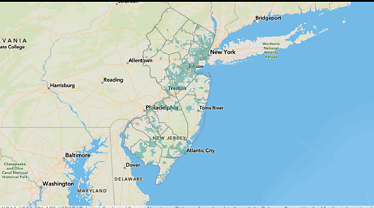October 16, 2024These three states have already passed laws to reduce cumulative impacts
Blog Post
Over 125 organizations in the Coming Clean network agree that reducing cumulative impacts on environmental justice communities is one of our collective policy goals, as outlined in the Louisville Charter for Safer Chemicals. We know that environmental justice communities are not exposed to only one polluting facility or one health-harming pollutant at a time. When reviewing permits for polluting facilities, regulators should have to take into account the combined harm of existing industry on community health, and should have the authority to deny permit applications from facilities that add to disproportionate pollution burdens and existing health stressors.
Passing cumulative impacts legislation at the state and local level is one promising way to make this possible. In 2021, Coming Clean released a policy brief by Drs. Nicky Sheats and Ana Baptista on state cumulative impacts legislation that passed in New Jersey, which we hoped would serve as a model for other states and cities. Since then, New York, Minnesota, Massachusetts, Connecticut and Colorado have also passed cumulative impacts laws. Cities and counties are also pursuing creative ways to assess and reduce cumulative impacts, while involving impacted community members in decision making.
Could your state or city be next? Read our Community Guide to Cumulative Impacts!
New Jersey finalized a historic Environmental Justice Law in 2020: the state now has the power to deny permits for 8 kinds of polluting facilities in overburdened communities.
 In spring 2023, Governor Phil Murphy announced the final adoption of regulations to implement New Jersey’s environmental justice (EJ) Law, which was passed by the New Jersey Legislature in August 2020. This law requires the NJ Department of Environmental Protection (DEP) to evaluate the cumulative impacts of certain facilities on overburdened communities when reviewing permit applications. If pollution from a new facility would cause or contribute to environmental and public health stressors at levels disproportionate to those in less burdened communities, then DEP is required to deny that facility’s permit. DEP cannot outright deny the expansion or renewal of existing polluting facilities, but can impose pollution controls to reduce their cumulative impacts on overburdened communities.
In spring 2023, Governor Phil Murphy announced the final adoption of regulations to implement New Jersey’s environmental justice (EJ) Law, which was passed by the New Jersey Legislature in August 2020. This law requires the NJ Department of Environmental Protection (DEP) to evaluate the cumulative impacts of certain facilities on overburdened communities when reviewing permit applications. If pollution from a new facility would cause or contribute to environmental and public health stressors at levels disproportionate to those in less burdened communities, then DEP is required to deny that facility’s permit. DEP cannot outright deny the expansion or renewal of existing polluting facilities, but can impose pollution controls to reduce their cumulative impacts on overburdened communities.
8 kinds of polluting facilities are impacted by this law, including gas fired power plants, landfills, incinerators, sewage treatment plants, transfer stations and solid waste facilities, large recycling centers and scrap metal facilities. Overburdened communities, which include most of the population in Newark, are identified using a state-developed screening tool, EJMAP. A community counts as overburdened if at least 35% of its members are low-income, at least 40% of its members identify as minority or as part of a state-recognized Tribal community, or if at least 40% of its members have limited English proficiency.
The law also requires polluting facilities seeking a permit or permit-renewal in an overburdened community to hold a public hearing and a 60 day public comment period. In order for a permit for a new facility to be approved, the burden is on the facility to show that it does not contribute to disproportionate health stressors on overburdened communities, for example, because it has installed more stringent air pollution controls, or electrified its fleet of vehicles. Alternatively, it must demonstrate that it serves a “compelling public interest.” The DEP’s rules make it clear, however, that raising local tax revenues or providing an “economic benefit” does not count as serving compelling public interest, which was an important community win. DEP suggests that composting facilities, renewable energy projects and water infrastructure projects may be able to meet this requirement.
What we’re watching: will NJDEP actually deny new permits, and use its power to require existing facilities to lower toxic emissions?
Organizations to follow: Ironbound Community Corporation, New Jersey Environmental Justice Alliance.
New York state passed a Cumulative Impacts Law in 2022, and is now in the rulemaking process
 New York’s “Cumulative Impacts Bill,” S8830, was passed in April 2022 and signed into law by Governor Hochul in December 2022. It prohibits agencies from approving or re-issuing permits for actions that would increase disproportionate and/or inequitable pollution burdens on disadvantaged communities. Some legal experts have argued that this makes it the strongest environmental justice law in the United States.
New York’s “Cumulative Impacts Bill,” S8830, was passed in April 2022 and signed into law by Governor Hochul in December 2022. It prohibits agencies from approving or re-issuing permits for actions that would increase disproportionate and/or inequitable pollution burdens on disadvantaged communities. Some legal experts have argued that this makes it the strongest environmental justice law in the United States.
New York’s law defines “disadvantaged communities” more expansively than New Jersey’s, as those communities “that bear burdens of negative public health effects, environmental pollution, impacts of climate change, and possess certain socioeconomic criteria, or comprise high-concentrations of low- and moderate-income households.” Criteria and lists of disadvantaged communities in New York were developed by the state’s Climate Justice Working Group and finalized in March 2023.
The new law requires the Department of Environmental Conservation (DEC) to require or prepare an expansive “existing burden report” that assesses a baseline of all existing sources of pollution affecting disadvantaged communities and the potential routes of cumulative human exposure for all of those sources.
Right now, New York’s law does not specify any exceptions that will allow facilities that will add to pollution burdens in disadvantaged communities to obtain a permit if they serve a “compelling public interest.”
But NY’s DEC still has to write the rules that will determine how this law is implemented, and it is possible that the New York State Senate will further amend the law to create such exceptions.
What we’re watching: How will the DEC interpret “disproportionate and/or inequitable pollution burdens” and will any exceptions be introduced as amendments to this law?
Organizations to follow: South Bronx Unite, WE ACT for Environmental Justice.
Minnesota signed Frontline Community Protection Act into law in 2023, will undergo a three year rulemaking process
 This law was signed by Governor Tim Walz in spring 2023, and requires state regulators to consider existing pollution levels in an area before approving or renewing a permit in or adjacent to an environmental justice community. The law will require the agency to conduct a cumulative impact analysis of existing pollution levels in environmental justice areas when considering approving a new air permit or renewing an air permit that has the potential to significantly increase local pollution.
This law was signed by Governor Tim Walz in spring 2023, and requires state regulators to consider existing pollution levels in an area before approving or renewing a permit in or adjacent to an environmental justice community. The law will require the agency to conduct a cumulative impact analysis of existing pollution levels in environmental justice areas when considering approving a new air permit or renewing an air permit that has the potential to significantly increase local pollution.
Environmental justice areas are census tracts where one or more of these conditions are met: More than 40 percent of residents are people of color; 35 percent of households are low-income; or 40 percent of the population has limited English language skills; or located within Indian Country.
The MPCA must deny a permit if the analysis determines it will cause “substantial adverse impact” on the community, but the exact meaning of this phrase is still being defined in rulemaking. Facilities found to cause adverse impact on EJ areas can alternatively enter into a community benefit agreement, but the requirements of these CBAS are also being determined in rulemaking.
The rulemaking process that is expected to take about three years, wrapping up in May 2026.
What we’re watching: Which facilities will be required to conduct additional EJ analysis when applying for a permit renewal? How will the MPCA define key terms like “substantial adverse impact” and what will be required in community benefit agreements?
Organizations to follow: Comunidades Organizando el Poder y Acción Latina (COPAL), Community Members for Environmental Justice, Minnesota Environmental Justice Table.

